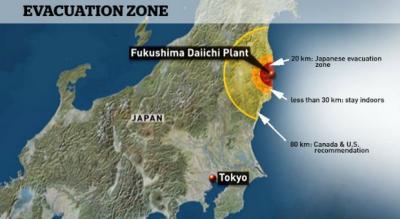

by Alexa Erickson, Collective Evolution
A massive undersea earthquake devastated the Japanese coast in March, 2011. As the world watched on in terror and horror, a tsunami forced Tokyo Electric Power Company-operated Fukushima Daiichi nuclear power plant offline.
The consequences of having placed a nuclear facility near one of the world’s most active fault zones soon became a major topic of discussion. According to a Japanese Parliamentary panel tasked with investigating the disaster, Fukushima was a “profoundly man-made disaster” that was “the result of collusion between the government, the regulators and TEPCO, and the lack of governance by said parties.”
The radioactive impact seemed immediate, yet six years later, the damage has yet to fully be assessed.
Now, the nuclear facility’s operator, Tokyo Electric Power (Tepco), has reported atmospheric readings as high as 530 sieverts an hour — the highest since the incident — inside the containment vessel of reactor No 2, one among three reactors that suffered a meltdown as a result of the tsunami.
While such reports further illuminate the devastation of the 2011 event, the political establishment and its corporate media continue to deem the catastrophe just another “conspiracy theory.”
Japan Times reports:
The commission asserted that the direct causes of the accident were foreseeable prior to the March 11, 2011, disaster. But Tepco, the regulatory bodies, and the trade and industry ministry promoting nuclear power failed to develop the most basic safety requirements, including assessing damage probability, preparing for collateral damage containment and developing evacuation plans. Both Tepco and the Nuclear and Industrial Safety Agency (NISA) were aware of the need for structural reinforcement at the Fukushima No. 1 plant to meet new guidelines, stated the commission, but rather than demand that it be done, NISA allowed Tepco to act “autonomously” and none of the required reinforcements were done by 3/11.
Since the disaster, Tepco has become notorious for underreporting and misrepresenting information regarding the event, and the company’s role in it. But in 2016, three former executives from Tepco were formally charged with negligence over the 2011 disaster for failing to take safety measures to prevent the nuclear disaster, proving that, despite the campaign to call people out as conspiracists for their concern over the extent of the damage, it’s a reality they cannot deny forever. In fact, the cover-ups must be exposed, especially given the recent news regarding the Number 2 reactor.
Tepco made the readings by analyzing electronic noise caused by the radiation in video images. The company says this technique has a margin of error of plus or minus 30 percent (so even at the extreme low ball, the levels are no lower than 370 sieverts per minute—but possibly as high as 690!).
Needless to say, this plant is not fit for human life. Just one dose of a single sievert is enough to cause radiation sickness and nausea. Exposure to four to five sieverts would kill about half of those exposed to it within a month, while a single dose of 10 sieverts is enough to kill a person within weeks.
Officials can’t seem to nail down the exact reason for the massive spike, however. Questions of whether previous readings were incorrect, inadequate, or if something was inside the reactor is being missed, have all been mulled over, but to no avail. Furthermore, Tepco hasn’t even found the radioactive fuel responsible for the meltdown, despite using highly-specialized camera-equipped remote control vehicles to examine the interior of reactors to pinpoint what physically occurred to the fuel.
“It may have been caused by nuclear fuel that would have melted and made a hole in the vessel, but it is only a hypothesis at this stage,” Tepco spokesman Tatsuhiro Yamagishi explained. “We believe the captured images offer very useful information, but we still need to investigate given that it is very difficult to assume the actual condition inside.”
A new camera was set to explore the Number 2 reactor, but due to speculation over what caused the spike, Tepco rescheduled its March deployment for the Number 1 reactor.

